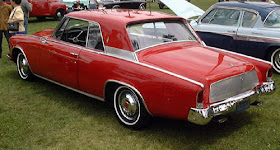That would apparently apply to car industry execs as well as cars. The more I reviewed the Studebaker story, the more I was struck by what an extraordinary guy Sherwood Harry Egbert was. The Studebaker board of directors, wanting to diversify and nudge the company out of the car business, picked the 40-year old McCulloch (industrial engines) exec for the job early in 1961, thinking that someone from outside the car industry would be ideal. And Egbert had a track record of getting results. After 2 years of junior college, he'd worked construction pre-war and taken on managing a crew of 800 to build a plant for Boeing, then won a Bronze Star with the Marines in the South Pacific during the war. When he got to Studebaker, he studied the car operation and fell in love with it, moving his wife and 5 sons to the lodge at Studebaker proving grounds near South Bend (that hedge spelling "Studebaker" in the aerial shot isn't a hedge…it's 5,000 pine trees). Within 18 months of taking the job, he had:
1.) Spearheaded the redesign of the Hawk, contracting it to Brooks Stevens Associates, and gotten the redesigned and retooled car into production within 10 months.
2.) Brainstormed with engineers and Loewy's Avanti design team* in a crash program to create a distinctively new performance car, and gotten it into production in about the time it takes General Motors to introduce new Chevy paint options (or discover an ignition switch failure and then cover it up). Egbert's hands-on approach out at the proving grounds had real results: The reason some of the switchgear is above the windshield header is that Egbert, a pilot, liked it there. And the one design flaw the car shares with the E-type Jag (a too-vertical windshield angle) is that way because Egbert bumped his head getting in and out of the prototype...

3.) Subcontracted redesign of the bread-and-butter car, the Lark, to Brooks Stevens and gotten that extensively revised body design into production by summer of 1963.
These initiatives involved epic battles with the Studebaker board, and the fight took its toll on Egbert's health. The directors proved that their hearts were firmly lodged in the same oblivion as their heads by firing Egbert as he was recovering from cancer surgery, on November 24, 1963. Egbert went on to found an industrial consulting firm in LA, and died at 49 in 1969.
*For a more detailed discussion of the Avanti, see "Lines of Influence",
the post from 2/17/16.
Photo credits from top:
1.) South Bend Tribune
2.) Wikipedia
3.) Autoweek
4.) carstyling.ru
5.) Raymond Loewy as published
on theavanti.net
the post from 2/17/16.
Photo credits from top:
1.) South Bend Tribune
2.) Wikipedia
3.) Autoweek
4.) carstyling.ru
5.) Raymond Loewy as published
on theavanti.net




No comments:
Post a Comment